Inis Mor
Sunday, September 10th, 2000
I have a penchant for visiting desolate places. The rest of the world can keep their rolling green hills and their soft tropical beaches. As far as I’m concerned, the windier and rockier it is, the better.
I guess this is why I had such a burning desire to visit the Aran Islands. The three islands off the west coast of Ireland - Inis Mór, Inis Meáin, and Inis Oírr (or Inishmore, Inishman, and Inisheer if you will - but I won’t) - are really nothing more than relatively tiny slabs of limestone jutting from the ocean and fighting a losing battle against the ravages of the cold Atlantic. They are the epitome of windswept rockiness. They are inhospitable, and it is for exactly that reason that I find them irresistible.
It’s not hard to get to the Aran Islands these days; there are numerous ferry crossings every day, and you can even go by plane from Galway. Their accessibility has made the islands a tourist destination. This is fortunate for the islanders who can now make money in the tourist industry rather than from the back-breaking work of farming or the dangerous work of fishing, but it’s slightly unfortunate for selfish people such as myself who like to have awe-inspiring places all to themselves. But despite the (other) tourists, I found more than enough isolation and emptiness on the Aran Islands.
Jeremy and I were visiting Ireland in late September of 1998. We had spent a few days in Galway and were getting ready to head back to Jeremy’s hometown of Cobh when I decided that I absolutely, positively had to get to the Aran Islands.
Time was short, but we managed to swing it so that we could get a ferry from Rossaveal to Inis Mór (the biggest of the three islands) and spend a few hours on Inis Mór before taking the ferry back again.
It was a short ferry ride through steely, slightly choppy seas. The weather had been nice in Galway and Rossaveal, but once we were out on the water the sky started to close in. I was soaking up the atmosphere and the salty air, thinking of Man of Aran and getting in the mood for some good grey desolation. I guess this is why the port on Inis Mór was a bit of shock.
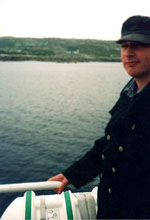
I don’t have any pictures of the tiny port of Cill Rónáin (Kilronan), I think because I just wanted to get away from it as fast as possible. As soon as you disembark the ferry, you are confronted by Aran islanders offering you tours of Inis Mór in cars or minivans or donkey carts. The main attraction on the island is the Iron Age fort of Dún Aonghasa (Dun Aengus), and you can hop on one of the vans and be whisked to the fort and back for a couple of pounds. Or you can take a 3-hour driving tour of the island in the comfy confines of a little bus. Or you can just dash straight to the pubs and souvenir shops that beckon colorfully from beyond the rows of vans and potential tour guides on the pier.
It was all very professional and touristy. It wasn’t what I was expecting. And it certainly wasn’t what I was looking for.
Luckily, the minivans are not your only option on Inis Mór. In fact, the best option is just to take off on foot. So, armed with a vague little map which we had picked up from somewhere, that is exactly what Jeremy and I did.
Inis Mór is small - about 9 miles long and 2 miles wide if I’m not mistaken. The port of Cill Rónáin is at one end of the island, and the famous fort of Dún Aonghasa is at the other. All the tourists - and hence all the vans and carts and bicycles and what have you - tend to head straight for Dún Aonghasa. This is one reason we didn’t necessarily want to go to Dún Aonghasa. The other more practical reason was that it was too far to walk in the time we had, and we weren’t about to hop into a minivan and be driven there.
We decided instead to head across the width of the island to another Iron Age fort called Dún Dúchathair, the “Black Fort”. We wandered through the town of Cill Rónáin, stopping to buy some candy bars and water to sustain us. The women in the shop were speaking Irish, to my delight. Then we headed out of town on the rough, stony road you can see in this picture. I don’t know what this red scrub was that I made Jeremy pose against, but it was the only splash of color against the endless background of tough green grass and grey stone walls.
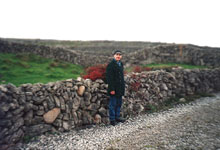
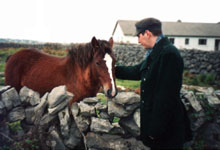
The quaint, picturesque side of Inis Mór. This friendly little pony was in a field along the side of the road. As you can see in the background of this picture, we weren’t too far out of town, because there were still houses here and there.
But in order to get to the coast and to the Black Fort, we soon had to leave the road and cut across the fields. And you don’t have to go very far before you have left all the houses and all the signs of civilization behind you. It’s not long before you are confronted with nothing but empty fields and mazes upon disorienting mazes of perfectly constructed stone walls.
We were, apparently, the only people on the island who had chosen to take this route. There wasn’t another soul to be seen or heard. So all on our own, we headed bravely for the coast.
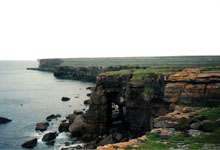
At the coast, you get a good feel for the geology of the Aran islands. The cliffs of the coast reveal the ancient strata of rock which have been blackened and rusted by the elements. The cross-section of the island shows you that any greenery on the ground is really a deception. There is no soil here. There is only barren rock covered by a tissue-thin layer of nutrient-rich seaweed, which was pulled from the ocean by the ancestors of the minivan drivers on the pier.
This picture shows a deep rift at the top of this natural arch. The immense boulders scattered at the base of the arch are testimony to the fact that the seemingly impenetrable rock of Inis Mór is giving in to the pounding of the ocean. I wonder how long it will take before the entire arch crashes into the sea, before the water has claimed this bit of Inis Mór for itself as well.
Standing at the top of these cliffs is like standing at the end of the earth. There is nothing but the steely sea pulsing in front of you, and nothing but rocky walls and rocky ground and low-hanging clouds stretched out behind you as far as you can see.
Such a small island - and yet once you reach the Atlantic coast all civilization ceases to exist. You can easily believe that you are the only one left on the face of the earth, and that the whole world consists of nothing more than these stones and this sea and those racing clouds.
As you watch the waves claw at the shore hundreds of feet below, you realize that the fundament beneath you is shuddering, crumbling, disintegrating under the onslaught of the wind and the wild Atlantic. You realize just how precarious your footing in this world really is.

We walked up the coast a ways until the only thing separating us from Dún Dúchathair (which you can see in the background) were these enormous black cliffs plunging down to the sea.
If I look dubious in this picture, it’s because I was. You can see the edge of the cliff just beyond the top of the stone wall that I appear to be gripping for dear life. I wasn’t standing right at the edge, but I could clearly see the edge. That alone was enough to make me feel lightheaded.
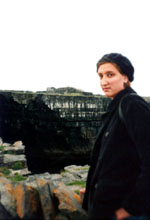
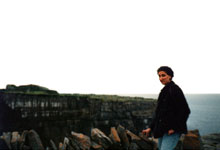
In this picture I settled for just touching the rocks of the somewhat fragile stone wall, just to give me some sense of still being connected to the earth.
Here you can kind of see how Dún Dúchathair looms over the ocean on its promontory. It’s apparently unclear whether forts like this were purposely built with one side open to the sea (a good defensive position), or if they were originally ring forts that have been chewed in half by the erosion of the millennia.
Even though these cliff forts are now little more than semi-circles of tightly packed stone, they are still incredibly impressive, even from a distance. They stand in solitary watchfulness over the rocky plain of Inis Mór and the endless stretch of the sea.

This picture gives you a bit more of a perspective on just how big and black these cliffs really are. The back of the remains of Dún Dúchathair can be seen in the upper right-hand corner. When you stand at the brink of this enormous trough that has been carved away by the water, you can see that the land is collapsing behind Dún Dúchathair as well as in front of it. I wonder if this line of erosion from the back will eventually make the fort inaccessible, or if the erosion from the front will cause Dún Dúchathair to fall into the sea first.
This is the only picture I have of Inis Mór that really shows how high the cliffs are in relation to a person (in this case, Jeremy). These cliffs are nothing compared to the Cliffs of Moher, but still, when you’re standing at the top of them, and it’s windy, and the rocks are loose and wet and slippery, and you can hear the waves thundering against the shore far, far below you, and there’s nothing to protect you and nothing to hold onto, and there’s really no one to hear you scream if you happen to slip and fall…then these cliffs are very, very scary.
I was scared to death for Jeremy standing as close to the edge as he was. The perspective of the picture makes it look as if I, the photographer, were standing half on the cliff and half off. Believe me, this was not the case. I wasn’t even close. I couldn’t make myself get close enough to the edge to look over and see the water below. And the fact that from here I could see that the cliffs were top-heavy, that the bottoms were eroding faster than the tops, making the tops hang over precipitously - well, there was no way I was going to go anywhere near the edge. No way.
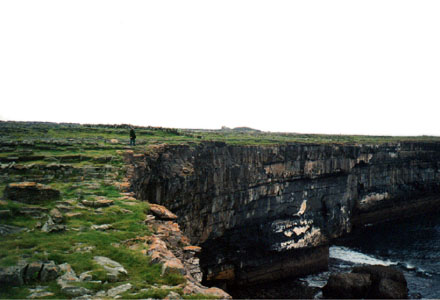
I did not want to fall (either over a cliff or otherwise), so I was taking my time walking. I was carefully climbing over fences and picking my way gingerly over the loose gravel and slippery slabs of limestone that “paved" the way to the fort. I was also taking pictures along the way, which held me up a bit. Jeremy went on ahead of me to scout out the situation at the fort itself.
From the outside, Dún Dúchathair is just a high, semi-circular stone wall. You can’t see over the wall, and there are no holes that would let you see through the wall. One end of the semi-circle ends right at the cliff’s edge; I didn’t even approach that side of the fort because, if I remember correctly, it was too precarious. At the other side of the fort the wall comes to an end about two feet from the edge of the cliff - and that’s a generous estimation. To get into the fort, you have to go around the end of the wall. That means that you have to traverse this two-foot wide strip of slippery earth between the end of a crumbling stone wall and the edge of a crumbling stone cliff.
I took one look at the situation and thought immediately that it was far too risky. I knew that neither I nor Jeremy would even consider trying to get around the wall to get inside. Not under those conditions. Neither one of us was that brave - or that stupid.
But despite my firm belief in this fact, there was one small problem: Jeremy was nowhere to be seen.
If fact, there was no one anywhere to be seen. There was nothing to be seen but this blank stone wall, and the edge of the cliff, and the empty landscape all around me. I was baffled.
I figured Jeremy was hiding, playing a trick on me or something, so I called his name. There was no response. I backtracked a bit, looked around the fort to see if I had just missed him, and called his name again. No response. I went back to the end of the wall and looked at it, trying to imagine Jeremy actually taking that route into the fort. It just didn’t seem possible. Then again, it didn’t seem possible that he could be hiding, either. There’s nothing to hide behind out there - no trees, no big boulders, no little hills.
I started to get angry. I thought that that if this was a trick, it was in mighty poor taste.
I shouted for Jeremy at the top of my lungs. No response.
I started to get scared.
Scared is the wrong word. I started to panic. I knew that, trick or not, if Jeremy heard me screaming, he would come out from wherever he was. I knew that he was not outside or around the fort. As unlikely as it seemed that he was inside, I thought that even if he were inside, he would have had to have heard me scream, and he would have come out. I thought that the only explanation for him not responding was that he had tried to get into the fort - and had fallen over the edge.
I told myself that this was absolutely ridiculous. Despite the fact that people do fall over cliffs - people fall into the Grand Canyon almost every year - it just seemed ludicrous to think that Jeremy had fallen off of Inis Mór. It would have made me laugh just to think it if I hadn’t been on the edge of terrified hysteria.
I screamed Jeremy’s name.
No response.
I don’t know how long I stood there with my heart and my thoughts racing, trying to understand the situation and decide what to do about it. It was probably no more than a minute, but it seemed like an eternity. There were no signs of human life anywhere around me. The rain was starting to come down. The wind was whistling past me and the waves were crashing below me, and those were the only sounds I could hear.
I couldn’t bring myself to go to the edge of the cliff and look over. I wondered if I should run back to Cill Rónáin. I wondered if I should try to get into the fort. I wondered if they would ever find Jeremy’s body on the rocks below.
I have never felt more utterly alone than I did in those few moments.
I took a shaking breath and screamed Jeremy’s name more loudly than I have ever screamed before. My scream was whisked away on the chill wind.
And then Jeremy’s smiling face popped up over the wall of Dún Dúchathair.
As it turned out, Jeremy had in fact braved the narrow strip of land and gone into the fort. He had been inside exploring some “blowholes" that went all the way down to the ocean below, and between the wind and the thundering of the water, he just hadn’t heard me calling for him.
The moment I saw I him the adrenaline kicked in, and I started shaking so badly that I had to hold on to the wall to remain standing. I was a laughing, crying, trembling wreck. Somehow I was convinced to go around the wall and into the fort, but I was so pumped up with the aftereffects of fear that I couldn’t take in what I was seeing. I’ve since read that there are the remains of beehive huts inside Dún Dúchathair, but I certainly didn’t see them. I had the presence of mind only to tell Jeremy to pose against the inner walls, and then I took this picture and got out of the Black Fort as quickly as I possibly could.
Of course, my hands were shaking so badly that the picture is a complete blurry mess. Now it kind of makes me laugh. Kind of.


We left the Black Fort. There were some other archaeological sites that we wanted to see, but we didn’t have that much time to wander around because we had to catch the last ferry back to Rossaveal. So we headed off across the fields again in the direction of Cill Rónáin - or so we thought.
The lack of any roads or paths and the monotony of the harsh landscape made it hard for us to stay on track, and what we took to be a more direct route back to the port turned out to be an obstacle-filled odyssey. We clambered over stone walls (knocking some over in the process - I apologize to the farmers of Inis Mór) and sloshed through muddy fields, and the fog rolled over the ground and the rain spit down on us, and I started to think that, as atmospheric and beautiful as all this desolation was, what I really wanted was a warm room, a nice comfy chair, and a lovely cup of tea. My adventurous spirit was giving up the ghost, so to speak.
But we eventually found the road again. The clouds started to break as made our way back into the town of Cill Rónáin. We had a bit of time to kill before the ferry set sail, so we went into a café and had a pot of tea and some delicious seafood chowder to warm ourselves up. After shaking the chill of fear out of my bones, I found myself wishing that we could stay on Inis Mór for a few days. As more and more of the people waiting for the ferry began to pour into the café with their big bags full of Aran sweaters and souvenirs, I found myself wanting to be back out on the bleak plains of Inis Mór with the wind and the clouds and the cold black rock. I wanted to be away from the chattering people. I wanted to be alone with the ocean.
But we had to get on the ferry, so we got on the ferry, and we sailed back to Rossaveal, and we drove back to Galway.
In the end, I do realize how easy it is to romanticize it all. It’s easy to gaze in fear and awe at the bleak landscape and feel happy to have “gotten away from it all”. It’s easy to wish that you never had to go back to the real world, easy to think that you could stand there forever with the ocean air salting your lips and be perfectly content.
It’s easy to forget that people had to survive on Inis Mór by squeezing whatever life they could from the broken ground and the raging ocean. Survival entailed creating fields from seaweed or knitting sweaters for the fisherman, sweaters so individualized that the sweaters’ wearers could be identified by the patterns in the wool when their bodies were pulled from the hungry sea. The island was cruel, survival was back-breaking, and life was really not romantic at all.
It’s easy to forget that the modern-day Aran Islanders at the pier, ruining the harmonious archaic quaintness of it all with their tour vans and trinkets, are also just trying to survive, and that the unforgiving land that is so appealing to me for the short time I am there is what they have to live with every single day. The tourists and the tourists’ money make life on Inis Mór a bit easier these days, but only a bit.
I think I would do well not to forget this. Any tourist to the Aran Islands would do well not to forget this. Romantic Ireland is not dead and gone; it never existed in the first place. The Aran Islands are intriguing and fantastically beautiful, but they are also lonely and harsh, and I make myself remember that it is really only in the warm, easy comfort of my modern world that I can dream longingly of the desolation of Inis Mór.
Comments
1
Reading this … article (as I guess I should call it) made me want to get on a plane and visit Inis Mor immediately. But then I read the last page, and I still wanted to go, but it was not as imperative as it was at first. This is quite a chilling and beautiful piece of writing, and it presents an issue that is very prevalent in my life.
It reminded me of a hiking trip I took near my (former) house in Colorado. I had just returned from school for spring vacation. I used to live right near Golden Gate National Park in Golden Colorado, and there are some wonderful hiking trails a few minute’s walk from where the house is. So I packed my backpack with a lunch, and some bottles of water, and my diary, and went out to do some soul-searching/relaxation/beauty-appreciation out in the Rocky Mountains.
Everywhere there were stunning views, the most romantic and daunting that one could ever imagine. Then, after several hours, I realized that I wasn’t even looking up anymore, I just stared at my feet as they plodded along on the trail, wet with the waters of the melting snow.
I was really horrified.
On the way back, I stopped at Buffalo Bill’s grave. There is a nice terrace up there, and so I went out and gazed at the land(city)scape, and then sat down and wrote this in my journal:
"Why is it that when we are presented with beauty in its fullest, most solid state, we can never enjoy it? It would seem that the true pleasure lies in flux and instability- we enjoy food most when we haven’t had it for quite a while- enjoy a symphony when we can’t hear it clearly or fully- enjoy mountains when they’re on a photograph. With modern existence so efficient at chopping up life and giving it to us in manageable pieces, one can speculate that in the past, no one enjoyed anything at all——-or that true beauty is inevitably internal: a most backwards and self-depriciating revelation."
No matter how untrue and/or specious I occasionally might find the individual statements in this fragment, I can never shake the memory of how horrible I felt when I was writing it. It was probably one of the most frustrating moments of my life. And I’ll never forget the lesson it taught me about my romanticism.
Sure I’ll keep wanting to visit wind-swept islands and ancient castles and volcanoes and so forth, but I’ll always remember how I felt on that fateful day in March and remember how important it is to enjoy the life that I have.
2
I am planning to go to Inis Mor, because my family actualy comes from Kilronan. You have a nice site.
3
Your description of the edge of the cliff and not wanting to get close to it made my skin crawl. The combination of the picture and your words made it very real.
4
I am planning a trip to the Aran island. Just like you I will try to stay away from the tourist. I would like to ask you, do you know of a place where I can stay for a night or two? Also, can you rent a horse and go horseback around the Island? Cheers
5
Have you noticed that most people when confronted with a cliff edge see how close they can get without falling?I visited Niagara Falls and found the water spilling over the lip quite hypnotic.
6
Just returned from Inis Mor…too sad, maybe I’ll return there next winter (I want too see it in its wildest look ;-)
7
I visited in Spring 2001… as for the cliff, the best I could do was crawl up to the edge of it like a snake to peer over. Out of all the places I’ve traveled in the world, this one sticks in my mind. I still look at pictures from time to time, to remember my day there.
8
Just got back from visiting Inis Mór… crawled up to the edge and managed to take a couple of shots over the 300 ft drop.. see if this works
If not visit: http://photos21.flickr.com/24497678_83ef76eb29_b.jpg
Nice write up by the way!!
9
Holy cow, that’s some picture, Neil! You’re much braver than I am - if I hadn’t been completely rattled, I wouldn’t have gone *near* the edge of the cliff…
10
I adore Inis Mor some dear friends of mine live there and I try and vistit the island every year it has some amazing sights I loved yor article it reminded me just how incrediable the islands are.
11
I visited Inis mor in 2006 and I was troubled. My heart is there… En français, j’ai eu un grand coup de coeur pour cette île où je rêve de revenir. Les stones, le vent et la pluie avec les éclaircies, rien ne m’a empêchée de continuer ma route à vélo… J’ai visité le fort principal sous une pluie battante avec les flots noirs en bas de la falaise. Et pourtant, une impression de liberté et de solitude extraordinaire…
Isabele Nail
12
I work as a tour guide and we are lucky to stay overnight on Inishmore. This allows me to walk the group (we are normally cycling) to the Black Fort in the morning before heading for the noon ferry. To me this is the better part of the trip, and I try to show my guests the beauty and solace of this place away from the tourists, which the Black Fort offers. The article is beautifully written.
Sorry. Comments are closed.